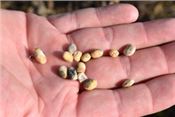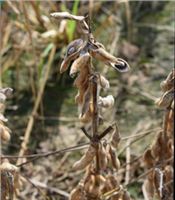|
Soybeans Suffer In Soggy September
ALEXANDRIA, LA.
The 2018 soybean harvest that started well has turned soggy, particularly for central and southwest Louisiana, according to LSU AgCenter soybean specialist Todd Spivey.
“Because of this wet weather, many producers have not been able to harvest a crop that has been ready to harvest for as long as three weeks,” he said. “This extended period of wet conditions has reduced grain quality tremendously, with samples harvested by producers being graded with as much as 60 percent total damage. This has led to countless acres that will go unharvested in 2018.”
Between Sept. 19 and Oct. 1, the LSU AgCenter H. Rouse Caffey Rice Research Station in Crowley received more than 3 inches of rain. During this period, only one day had no measurable rainfall.
“Harvest had been progressing quickly through the first two and a half weeks of September and has since stalled with only 3 percent of the statewide crop being harvested from Sept. 23 to Sept. 30, compared to 15 percent in the week prior,” Spivey said.
“This extended period of rainfall and the subsequent cloudy, humid conditions associated with weather like this have been devastating for the soybean crop across the state,” he said.
The soybean harvest season began with good results. High yields were being reported across the state, with high quality and low total damage. But Tropical Storm Gordon passed through in early September, leaving moisture that reduced grain quality slightly. Some producers were reporting total damage of 5 to 10 percent, compared to 1 to 3 percent before Gordon.
Because of damage issues, producers are also having trouble selling what has been harvested. Spivey said many grain elevators have limited the amount of acceptable damage to 5 to 7 percent. Soybeans that are graded worse than 5 to 7 percent damage are being rejected at the buying points, leaving producers with questions as to what options they have to move their crop, he said.
“Some elevators are also only accepting soybeans under contract,” Spivey said.
Most of the damage currently being found includes weather-damaged kernels, mold and sprouting, depending on the stage of the soybean when the poor conditions began, Spivey said.
Weather-damaged and rotting soybeans are typically brown to black and often misshapen. Mold can also begin to develop on seed exposed to extended wet conditions and can either invade the seed or occur on the surface.
“Sprouting of seed inside the pod has recently been seen more in younger soybean fields that have not been desiccated,” Spivey said.
In extremely wet conditions, sprouting in the pods can occur any time after the seed has become physiologically mature and the seed moisture has dropped below 50 percent. Though sprouting is usually minor in a field, producers can see an increase in foreign matter in the combine as sprouted seed as well as a reduction in test weight, he said.
“Unfortunately, seed quality has become a hot topic as many producers faced similar issues in 2017 as well due to the lingering effects of Hurricane Harvey that came through Texas and Louisiana in early September,” Spivey said. “This is the second year that many growers had a strong crop throughout the growing season only to see it be decimated by the poor fall weather.” ∆

Damaged soybeans as the result of excess moisture at harvest time. Many farmers are
having trouble selling their soybeans because the damage amount exceeds the limits set by buyers
Photo by Todd Spivey/LSU AgCenter

Damaged soybeans are present in the pods in a field yet to be harvested
Photo by Todd Spivey/LSU AgCenter
|
|